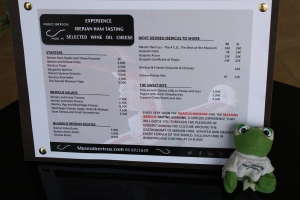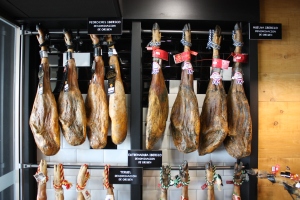
Spain is home to some of the most delicious food I have ever eaten! When I was first planning my trip to Spain, I dreamt of paella and churros. However, my research also

pointed me to a mystical Jamón Iberico. This ham was to die for! While I love to eat, I also love learning about my food. For that experience, I visited Museo Ibericus in Benidorm, Spain.
At the half restaurant, half cured-ham classroom, I was taught what to look for if I were to ever purchase my own Jamón Iberico. There are four Denominacion de Origen to be aware of when selecting a ham: Guijuelo, Huela, Extremadura, and (Valle de los) Pedroaches. These areas are located in Southwestern Spain, and if your ham doesn’t have this stamp of approval, this is not the ham you are looking for! Another thing to look for is the pata negra, or black hoof. While there are white-hooved pigs being cured into delicious hams, Jamón Iberico is specifically known for the pata negra so don’t be tricked!

Lastly, like your grass-fed beef, it matters what your Iberian pig grazes on! The most praised is Jamón Iberico de Bellota. Bellota translates to acorns, which is the sole sustenance of these free-range pigs. There is also de Cebo, which is when the pig grazes on a combination of acorns and seeds.
So what does this divine treat taste like? The thinly, hand-sliced ham is meatier, drier, and not as salty as its counterpart Jamón Serrano and the Italian prosciutto. The fat is thick and has a melt-in your mouth consistence. It is so simple yet so delicious that it really stands alone. Pair with some cheese and bread, and you have a full meal on your hands!
Now you are better-versed in the world of Jamón Iberico, you may be asking where you can find this wonderful treat outside of Spain (and Portugal, though I didn’t go there). I can only speak for the US, but it has been available here since 2007! It is very expensive (often over 100 USD per a pound), but I think a small sample size is worth the 20 dollars. I was able to track some down at HEB, but it can be found at tapas restaurants as well. And if that isn’t your style, you can always find your way to Spain where the it is readily available and reasonably priced!
Museo Ibericus is located at Av. Armada Española, 21, 03502 Benidorm, Alicante, Spain. You can reach them at +34 966 81 16 39

